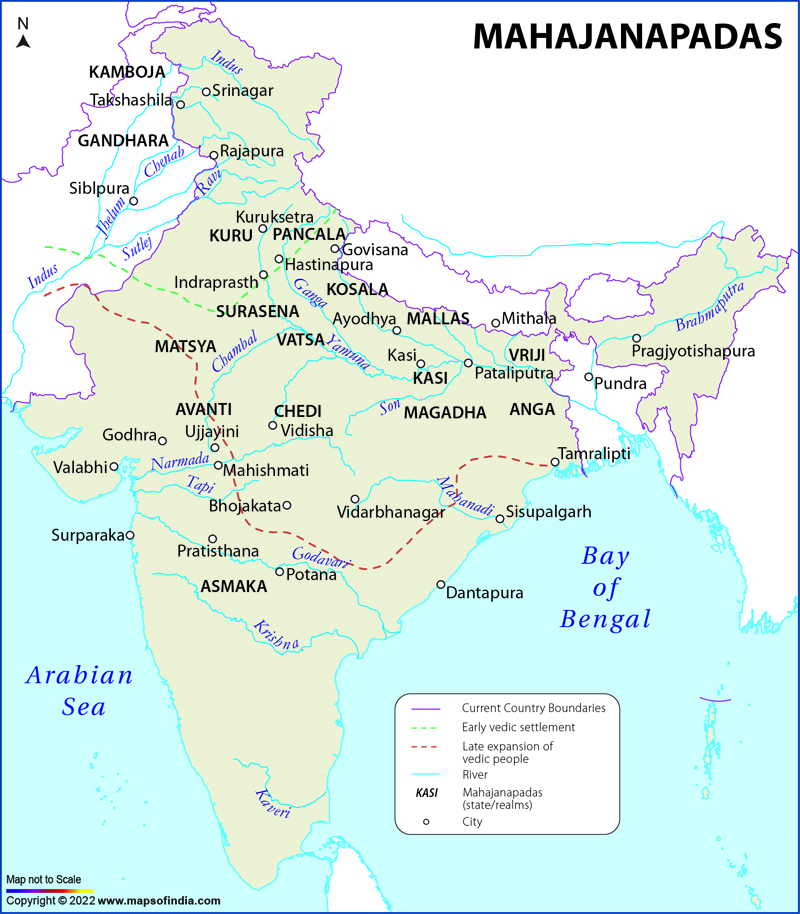Literally Mahjanapadas means 'Great Kingdoms'. Before 'Budhism' rose in the country, these flourished in the north western parts of India. Aryans were seen migrating to the country. As per the Vedic texts these Aryan tribes were known as the Janas. Later these Vedic Janas merged with Janapadas. The Indian subcontinent was divided into the Janapadas with clear demarcated boundaries. Many of these became big political bodies. In the Budhist traditions these kingdoms came to be known as 'Mahajanapadas'.
There were sixteen of such Mahajanapadas: Kasi, Kosala, Anga, Magadha, Vajji, Malla, Chedi, Vatsa, Kuru, Panchala, Machcha, Surasena, Assaka, Avanti, Gandhara and Kamboja.
Kasi is a region settled around Varanasi. It has a predominant position among the sixteen Mahajanapadas. Matsya Purana and Alberuni talk immensely about Kasi read as Kausika and Kaushika there. Also we come to know much about Kasi from the folklores of the Jatakas.
Kosala comprises of Shravasti, Kushavati, Saket and Ayodhya. Also it constituted of the modern cities of Oudh (Awadh), Uttar Pradesh. Ayodhya was under the control of the Kosala king Prosenjit. A neighboring state was the famous Magadha.
Anga was one of the earliest of all. This was around the Gangetic plains. This state was known by various names such as Malini, Champapuri, Kala malini, Champa malini etc. it was in the Atharva Veda that the Angas were first mentioned.
Magadha was a powerful kingdom and was run by Bimbisara and Ajatshatru, his son. As per the Vedas Magadha is the 'semi Brahman' state. In the later Vedic scriptures and texts it was referred to as Kikata. Also it is popular by various names as Magadhapura, Brihadrathapura, Vasumati etc.
Vajji comprised of many different social groups and villages. It was a confederation of many clans such as the Licchavis, the Vedehans, the Jnatrikas and most importantly the Vajjis. Its capital was located at Vaishali.
Malla has been mentioned in the Buddhist and the Jain works. It existed in a republic of nine territories. The Mallas were known for their bravery and warlike temperament. They were conquered by Magadha after Buddha's death.
Chedi people existed on the southern part of the Yamuna River. The capital of Chedis was Suktimati and the Rigveda gives details of this Mahajanapada. It was ruled by Sisupala and it was this city where the Pandavas (from Mahabharata) chose to spend the thirteenth year of their exile.
Vatsa or also Vamsa followed a monarchial form of government. The capital of this Mahajanapada was located at Kausambi. It became a hub of all the economical activities, business and trade.
Kuru basically belonged to the Puru-Bharata family. These were the people who originated from Kurukshetra. They are believed to have shifted to the republic form of government in the fifth of the sixth century BCE.
Panchala was divided into two parts: Uttara Panchala and Dakhsina Panchala with Chhatravati and Kampilya there capitals respectively.
Machcha was located to the south of Kuru and west to the river of Yamuna. As per the Pali literature the Machchas are generally linked with the Surasena. Its capital was Viratanagara.
Surasena witnessed great metamorphism in religion. Its capital was Mathura. Earlier Lord Krishna was worshipped here later the disciples of Buddha took over this Mahajanapada.
Assaka also known as Ashmaka, this was situated in the southern part of the country. Its capital was located at Potali.
Avanti lay in the western India. This kingdom nurtured Buddhism immensely. Its capital was known as Ujjaini. Initially its capital was Mahissati which later was integrated into Ujjaini. Avanti later dissolved in the Magadha Empire.
Gandhara comprised of the Gandharas who were believed to be excellently tarind in the art of war and have been mentioned in the Atharva Veda. The Gandhara are included in the Uttarapatha by the Puranic and Buddhist traditions.
Kamboja was believed to have consisted of the areas around the Hindukush. It is mentioned in the great epic Mahabharata in many excerpts.
Last Updated on : November 13, 2025
Mahajanapadas Map |
| ||||||||
 | ||||||||
|
|
*Map highlights refers to sixteen great nations existing before the start of Buddhism in India.
Disclaimer: All efforts have been made to make this image accurate. However Mapping Digiworld Pvt Ltd and its directors do not own any responsibility for the correctness or authencity of the same.
Disclaimer: All efforts have been made to make this image accurate. However Mapping Digiworld Pvt Ltd and its directors do not own any responsibility for the correctness or authencity of the same.